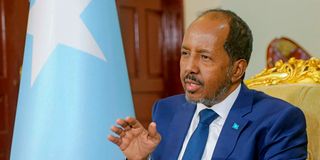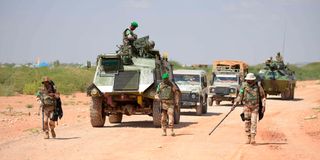Prime
Years after the ‘revolution’, Somalia still searches for true democracy

Somalia's President Hassan Sheikh Mohamud speaks during a past interview inside his office at the presidential palace in Mogadishu, Somalia on May 28, 2022.
What you need to know:
- Mogadishu had suddenly become the safest capital in Africa if not in the world.
- Within a year, the struggle to regain democracy emerged with some members of the SRC feeling resentment by the dictatorial nature of the new rule.
Abdalla Ali, a lecturer at a university in Mogadishu recently checked on Mohamed Osman, a relative recently put down by illness.
The visit became some kind of trip to a museum. Osman was a civil servant in Somalia’s good years in the 70s and 80s.
Osman rose through the civil service before Somalia fell among warlords in the late 80s. But their dialogue revealed something: endurance and hope that Somalia’s decades-old problems are just passing clouds.
“No matter how bitter what we are experiencing is, it’s a good effort at getting true democracy in Somalia,” Ali said after listening to his relative explain their country’s history.
Somalia’s records were mostly destroyed in the civil war. So young folks usually learn their history listen to oral narrations from the old guards.
“It is meaningless to remove a security-guaranteeing system to replace it with a worse, never-ending violence,” Osman remarked, remembering the country’s turmoil.
It began in 1969 when 25 army officers led by the late Brigadier General Mohamed Siad Barre overthrew a democratically elected government. A year later, they declared scientific socialism as the guiding philosophy.
Those tolerant of the military coup were simply considered ‘kacaan’ (revolutionaries) while those who dilly-dallied or even opposed were labelled as ‘kacaan-diid’ (anti-revolutionaries) or even reactionaries.
The coup came nine years after Somalia’s independence from colonial rulers, Britain and Italy. Many people felt that democracy was working reasonably well with the country holding three general elections and two presidential elections, all universal suffrage. Somalia has failed to hold such one-person-one-vote elections ever since.

African Union Transition Mission in Somalia (ATMIS) troops during a routine drill in Beletweyne, Somalia on November 23, 2022.
The army officers with star rankings on their shoulders held the Horn of Africa country with an iron grip. They started with abolishing the constitution, imprisoning the then Prime Minister Mohamed Ibrahim Egal, his entire cabinet members, and disbanded both the legislative assembly and the leadership of the judiciary.
Barre cleared all traces of democracy by jailing even the first President of the Republic, widely considered as the father of the nation, Aden Abdulle Osman better known as Aden Adde (Mogadishu’s main airport is named after him) as well as the then Speaker of the Parliament Sheikh Mukhtar Mohamed Hussein.
Those who staged the coup argued they could not tolerate election rigging, corruption, nepotism and all other socio-political maladies.
Ruling by decree, the Supreme Revolutionary Council (SRC) under Barre immediately promulgated regulations that dictated death penalty for counter-revolutionary activities, economic sabotage, financial embezzlements and other described crimes.

Somalia's military patrol following an operation against al-Shabaab on June 22, 2021. Recently, Somalia's military unusually withdrew from a clash with al-Shabaab that they have been winning.
Mogadishu had suddenly become the safest capital in Africa if not in the world.
Within a year, the struggle to regain democracy emerged with some members of the SRC feeling resentment by the dictatorial nature of the new rule.
Senior SRC members General Salad Gabayre, General Mohamed Ainanshe and another senior army officer Colonel Abdulkadir Dhel were found guilty and jailed for conspiring against the revolution and executed in 1972.
The convicting and killing of the three high-profile figures eroded all acts against the junta’s ruling. Fear overcame most people.
A good number of projects were implemented, including writing of the Somali language using the Latin alphabet, rural development campaigns and massive infrastructure rebuild such as inner city and cross-country roads, sports complexes, ports, airports and industrial complex.
Education was targeted, pronouncing primary schooling mandatory, and free.
The choice was limited to either obeying a dictatorial system that controled every aspect of life including the media, communication, faith and even the social side of the people. The most important being the almost hundred percent security guarantee.
Those who cherished freedom of association and expression kept low profile for a decade. But then it exploded like a volcano with armed rebellion emerging one after another.
The Somali Salvation Democratic Front (SSDF) and Somali National Movement (SN) emerged first to fight the pseudo-socialist regime with programmes to restore democracy in Somalia. Later, other rebel groups like Somali Patriotic Movement (SPM) and United Somali Congress (USC) were formed.
But, since the rebel groups were formed by individuals associated with different clans, the whole rebellion took an ugly shape marred by inter-clan rivalry.
In January 1991, Siad Barre’s totalitarian rule was defeated. But rather than uniting his enemies, it worsened the splinter.
Instead, they fragmented the country into fiefdoms, even paving the way for radical Islamists to proliferate, resulting in the emergence of groups linked to Al-Qaeda and the Islamic State (IS) affiliates.
Today’s reality in Somalia is that instead of a unified country under dictatorial rule, the pro-democracy rebellion created a federal government, five federal member states and one unilaterally declared Republic of Somaliland.
Those who like Mohamed Osman treasure peace and tranquility nostalgically recall the days of the junta. Those who uphold democracy as the most ideal for a nation are disturbed by the current situation, but never esteem dictatorship.
“No sound human can accept dictatorship,” said Abdalla Saney, an engineering professional in Mogadishu who survived a huge explosion orchestrated by religious extremists.





